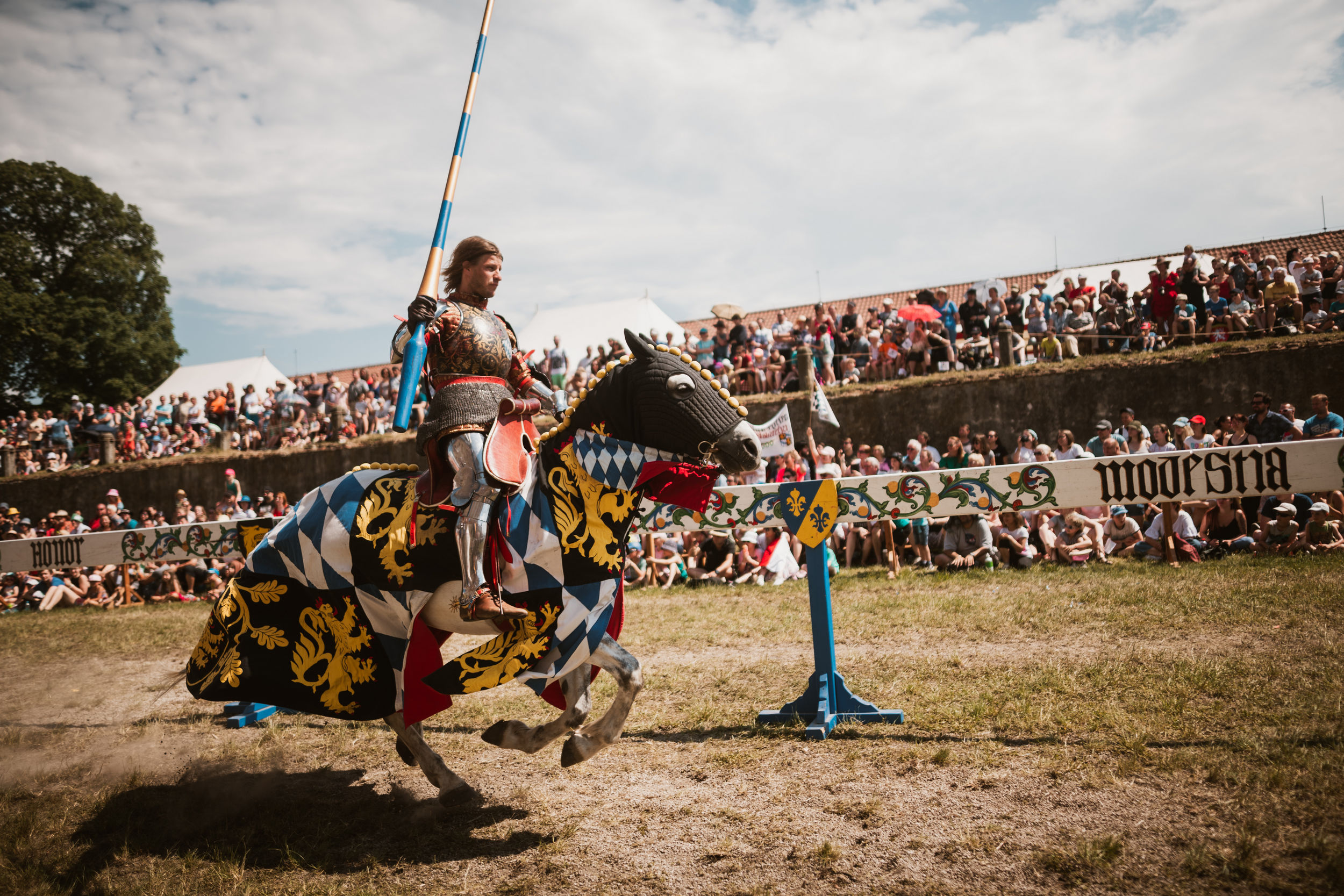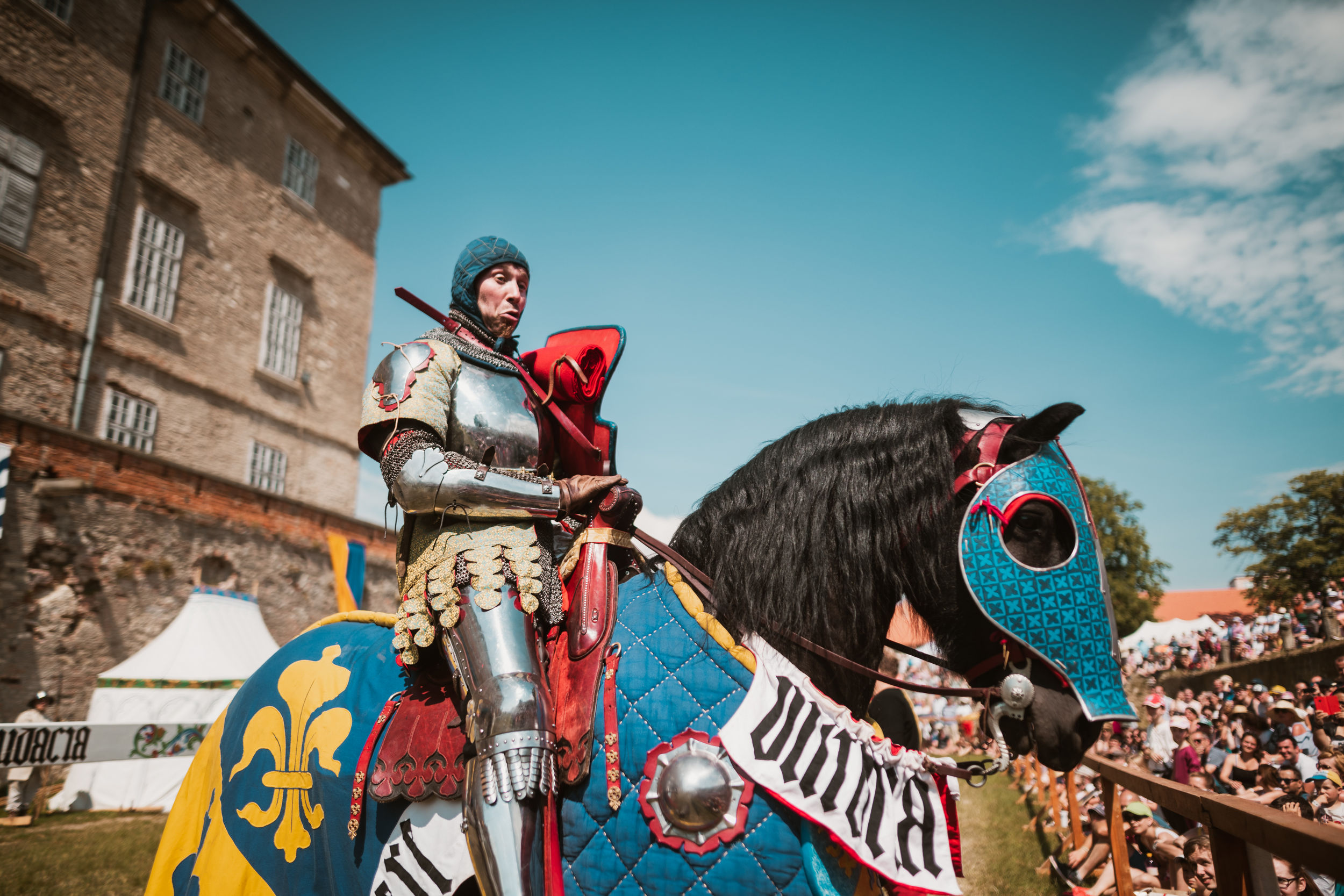
About knight tournament
The Hector Knight Tournament is set at the turn of the 14th and 15th centuries, so that you can enjoy the best the knights' world has brought.
Squires fasten plate armor to their masters, covering the weak spots with a ring mesh. Gold knightly belts wrap their loins. Horses are waved into heraldic batons, precious brocades and alabaster to present their masters' houses. Mythical figures, dragons, wolves and lions horribly screech out of the colorful flags that mark the boundaries of the arena.
Ladies meet on the grandstand. They do not show any sign of struggle while bearing the burden of dress. Often three layers of plush fabrics with sewn pearls and precious stones weigh tons on their shoulders. With a flick of the stick, Marshall starts the tournament.
Knights are competing for favour. With the lance, they turn the dangerous quintan around them, show the accuracy of their hands when stabbing the rings, and swerve quickly between squires to complete all the tasks that the ladies present invented. All this is only a prelude to the largest theater.
Joust. It's really dangerous fun. Always two opponents. In a fraction of a second, the horses reach full jets, a brief moment of decision and a crushing impact. Who will fall, who will break the shield, who will lose the precious jewel from his head, and who will remain the winner of this raid?
These are the most challenging moments of our performances. Well, fun doesn't stop there. Each knight must be shown in Nachturniere. Quickly change direction and maneuver in the tangle of horses, merge with the horse in one to finally hit a hard blow to the opponent's jewel. This is the only way he can get the ladies on the grandstand.
Our knightly cavalry

BERTRAND DE BEZIÉ AND HORSE JACK
Mr Bertrand is a long-standing favorite for ladies whose priorities are wealth and personal gains. The once humble knight today celebrates his immense wealth and properties.
Mr. Bertrand's biggest advantage is his beautiful black destriér (military horse) from Friesland. When you feel the ground shaking, be prepared for the arrival of Mr. Bertrand de Bezie and his powerful stallion Jack
DUKE HENRICH WITTELSBACH AND HORSE LUCAS
The young duke's reputation precedes him. He is the owner of the wild stallion Lucas, who often entertains the whole tournament company. Duke and his horse love to be thrown into the swirl of swords and clubs in the well-known melee discipline. It is not a secret, that the Duke does loves to challenge his own teacher - Charles de Loraine in joust discipine.
Wittlesbach is the first knight to have a personal Slovak fanclub. His supporters are waiting for the him at the knight festival Rotenstein.
ANGELO DA CHAMPAGNE AND HORSE RUDIGER
Beautiful, mysterious, modest.
Gentlemen draw their swords from the sheaths when they hear his name.. No one knows where he came from or from where he has the money.
Bad tongues say his father was a Genoese sea captain and then under the flag of a corsair looted merchant ships in the Adriatic and Mediterranean. The Black Swan, the flag of the Corsair became the symbol of Angela da Champagne.
VOJVODA KAROL LOTRINSKÝ AND HORSE OIASTIZO
A couple which jousted all across the Europe. A couple which knows no compromises in any of the tournament disciplines.
The couple who still prove to the young knights that the age is not important, but the experience always prevail. Anyway, Duke Karol Lorraine and his horse Oiastizo are always the decoration of the tournament.
Especially ladies should look forward to the always polite knight in a truly beautiful outfit.
VAJK HUNYADI AND HORSE RENÉ
The poor knight of the Hunyadi family, Vajk, is the youngest of the three brothers. His family has the property in Hungary, but as the youngest of the brothers he did not enjoy much of it. As the third son in the family, he was meant to spend his life in the monastery and become an obedient monk. Vajk decided to dedicate his life to the study, literature and tournaments.
He is attracted by knowledge, is a passionate reader of ancient literature. He dreams of tournaments where knights exchange horses for modern steam horses.
RYTIER IOANUS DE SANCT IACOBI AND HORSE DIEGO
Knight Ivan, known in the world of gentlemen as a prominent host, excellent traveler and expert marksman. He undertook few challenging trips to the east, where he attended few, horse archery tournaments with the fearsome Ottomans.
Mr Ioanus de Sanct Iacobi has shown in several tournaments over the past few years that he can deliver promissing result in any discipline, even joust.
Historical column
TOURNAMENTUM, TURNIER, TOURNAMENT
Although today, under the influence of film culture, the term tournament refers mainly to jousting, or the whole festival, it was not so in the Middle Ages.
The tournament was understood only as one discipline in which several knights usually stood against each other. Sometimes there were hundreds of them. Their task was to stand up in a mass fight that often resembled a real battle. A large number of injuries in this discipline caused the gradual formation of various rules, restrictions, or proxy weapons.
The winner was chosen by the ladies present on the basis of the valor and skill of the knight.
HASTILUDIUM, STECHEN, JOUST
This discipline takes different names and over the course of history has gained many variants, whether due to regional or customary popularity.
But the essence has always been the same. The two riders stood facing each other with long lances trying to hit the opponent. Let us mention for example the variants stechen and rennen. The stechen used a relatively thick cradle with an iron crown and the purpose was to break into as many pieces as possible. The aim was not to throw the opponent off the saddle, which was adapted to the so-called high saddles with a strong backrest. There was a high barrier between the opponents. Rennen was another story. Read on:
HIGHLIGHT OF TOURNAMENTS - RENNEN
Rennen was a popular variant of the joust especially in German countries. The opponents were mostly weakly armed, seated on low saddles, but there was usually no barrier between them. The task was to eject your opponent from the saddle. Often, rivals agreed that the tournament would not take place in relatively secure tournament armor, but would enter into lighter military armor, and the spears would not have a secure crown but a sharp point. Although it might seem that this variant was a rare opposite, it is true and kept its popularity until the end of the Middle Ages.
Of course, let us not forget that for all variations, the head was a priority, not a shield.
Nachturnier
The literal translation of the title of this discipline "after the tournament" indicates what it was.
This discipline really took place at the end of the Tournament Days, as fun or simply if the knights did not have enough. The task of the knights was to throw down or destroy the opponent's jewel, the adornment of the helmet, in a mass fight. For this purpose, they held blunt swords or wooden threshers in their hands.











